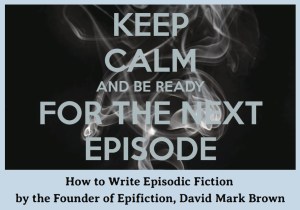 This post is the third in a series. For the first post (making a case for episodic fiction and emphasizing the importance of having a clear EndGame), click here.
This post is the third in a series. For the first post (making a case for episodic fiction and emphasizing the importance of having a clear EndGame), click here.
While episodic fiction is inherently plot or event driven, no one will care about the events without interesting characters. An episode is when such and such happens to what’s his butt. Over time, if a serial is to maintain the reader’s interest, the character dynamics must continually evolve.
Joss Whedon is the Master
Before vampire slaying was cool, Whedon gave us Buffy. He later gave us Angel. For those Browncoats out there, he briefly gave us Captain Reynolds and crew. I think one of Whedon’s greatest talents is balancing character dynamics over the span of numerous episodes. A large part of his success in this area is due to his tendency to kill off beloved characters. You might be thinking, “WTF! How does that make a serial anything but painful!” The answer: It keeps you fully invested in every single scene, because you never know when it might be that character’s last.
Writer on Character Violence
Like in all things there is a balance when it comes to writer on character violence. Too much can leave readers so frazzled that they simply can’t carry on. In television, the successful spectrum of writer on character violence can range from the extreme of Twenty Four to the other extreme of Castle.
When Twenty Four first aired, I remember the utter shock of how casually the show would toss away main characters. The character is there one minute, and then “boom,” a bullet to the head the next. Only Jack was safe (and by safe, I mean he could be tortured and robbed of all humanity, but never killed).
I prefer a balance somewhere along the lines of Battlestar Galactica. That show created a large enough cast of important characters to regularly kill/disappear one. Plus, the show devised a complex means of resurrecting characters that allowed for even more permutations for character interaction. And that’s ultimately the name of the game. If you are going to dip from the same well fifty plus times…
You Gotta Shake it Up
When it comes to character interaction, you don’t have to kill a character to radically alter relational dynamics. Falling Skies is an excellent example of this. The show begins with a father protecting his two sons and fighting as part of a resistance community. His third son has been “harnessed” by the aliens. Midway through the first season, the harnessed son is rescued. The son’s living bio-mechanical harness is removed from his spine. The middle son is no longer controlled by the aliens, but he is now known within the broader resistance community as a “razorback.”
By doing this, Falling Skies is not only able to birth a new character into the dynamics, but the series also births a new category for characters in the community. Now there are aliens, resistance fighters, and people who are strangely a combination of both. This dramatically effects character interaction. Some characters are suspicious, some hateful, some compassionate.
This is All Part of Character Death and Rebirth
The most interesting character in Falling Skies is a mercenary type known as Pope. In nearly every episode that he appears, his character evolves. He ranges anywhere from psychopath, to anti-hero, to renaissance man. He disappears from the show in stretches due to his anti-social behavior. He gains popularity by killing aliens and then loses it by trying to kill the main protagonist.
It is characters like Pope that continually turn the prism of a serial to catch different aspects of the light. No one agrees on how to deal with him, and even individual opinions change from episode to episode. Pope is episodic gold.
Episodes are by their nature formulaic simply due to the fact that they borrow from the same fictional world over and over and over. When done right, the formula becomes comforting for the reader. The fact that the reader already knows the world and cares for the characters can be a huge strength of writing episodically. But the flip side of that coin is the risk of becoming stale and predictable. The easiest means of staying fresh is through character death and rebirth.
Nobody Has to Die
At its most subtle, character death and rebirth can involve shifting the focus from one character to another. If each of your main characters can support an entire episode, all the better. Remove a character from an episode or a mini-series of episodes. Put a character through a life altering event. Bring in a new character. Shift a character’s allegiances. All of these options should remain in your arsonal.
By focusing on:
- The EndGame
- Mini-series arcs
- Episode arcs
- Character death and rebirth
- Along with all the basics of good story writing
Episodic fiction can become a brilliant means of regularly engaging a community of true fans. Due to the manageable length of episodes, a single writer can easily produce and publish them on a monthly basis in order to keep his/her readers constantly engaged. But this continual, live nature brings up a whole new bucket of worms: the beginning has to be published before the ending has been written. More on that next time!
As usual, feel free to sound off in the comments. If you are a Browncoat, say hi!